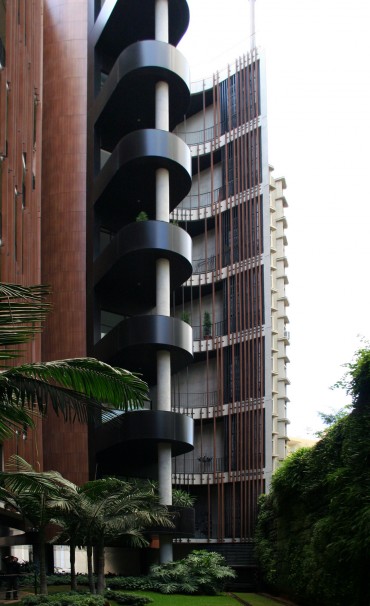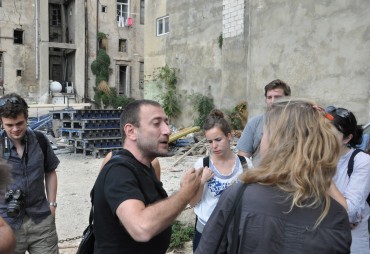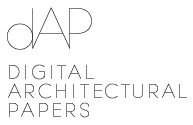
Bernard Khoury with Chair Josep Lluis Mateo students during the visit to Beirut, fs2010

IB 3, Beirut

IB 3, Beirut

Bernard Khoury with Chair Josep Lluis Mateo students during the visit to Beirut, fs2010
4.7.2012 – Issue 6 - Middle East 1 – Ivanišin Krunoslav, Khoury Bernard – Videos, Interviews
THERE IS A COMBAT IN EVERY CONTEXT
Interview with Bernard Khoury
And when we move from these private projects with a certain public purpose to the more “normal” projects like the residential blocks with very neutral, generic names, such as #183, IB3, #732, #893 etc? Do these projects for everyday purposes reflect the same experimental origin somehow?
I think there is a combat in every context and in every situation and I like to call myself an architect of the present, an architect of the situation. In my early projects in the beginning of my career, I was dismissed by some critics as somebody who can only operate in sensational context such as entertainment, which is where I started. Strangely, today, the majority of my work is in housing, is the residential sector. Not even housing, I call it residential because I work for developers. But I like to think, and I am deeply convinced that the combat is still going on another level, maybe on more subtle terms. I have been at war for the last few years with certain typologies that have defined what the standard is, what the living standard is, what the dwelling is in my part of the world and I have managed crush the model. Today we have nine buildings under construction in Beirut which defy these models and will definitely have an impact, not only on those who will inhabit these spaces, but also on the surroundings of these projects. They are aimed to be relevant in the ventures in the city as another way of inhabiting the city, another way of dealing with the neighborhood, another relationship with the outside, another relationship with the fabric, another relationship with the elements. This might not be looked at initially, for those who look at my projects with a more superficial eye, as being political, but I think they are. They definitely are. You have to understand that I have been a prisoner of a certain identity that has been built around my entertainment projects which were very easily tied or related to the war. Or at least in the circulation and the way they were interpreted. Most of my residential projects have to deal with the present. The issues that are not so directly connected with the war or at least the imagery is not so obvious. But I would like to think that these projects are extremely contextual, and that they are a product of the context.
So in a way the buildings you produce are cultural objects that interpret the reality around them?
Interpret or reinterpret. I don’t think these projects try to give consensual definition of what my city is. I have no problem contradicting myself from one street corner to the other if the situation pushes me to do that. My buildings do not look alike. I am not Zaha Hadid, I am not Frank Gehry… Good or bad is not the issue, but they are not objects that are recognizable through its form, or from their aesthetics, I am not interested in that. They are devices, they are about strategies. They are about provoking certain relationship to the city or the immediate situation. They are about provoking certain behaviors and certain situations that will hopefully be relevant and provoke pleasure. Pleasure is extremely, extremely central in my work. Whether it is for the entertainment sector, or whether it is even for inhabiting the space; pleasure not in the naïve sense of the term. I think pleasure can be harsh, pleasure can be sour, pleasure does not necessarily have to be sugar coated.
I would say that the contemporary architectural reality of Beirut is quite a generic one, with this kind of institutionalized ideology of the reconstruction of the supposedly authentic Levantine city. In this context, your objects which interpret the context in a particular way gain different importance.
Yes, but it is interesting to see what the “historical heritage” means in our part of the world. It stops at a certain period of time, which you just described as Levantine… I would say it stops with the end of the French mandate. History stops there, and that is a very dangerous simplification. I am much more interested in the history that is in the making. And again, I am an architect of the present. And when we talk about modernity, I think we’ve witnessed an architectural bankruptcy in the last few decades, as we were not able to contribute to modernity. In big majority of the “modern” buildings you see, except for very very few exceptions, the “modernity” is imported mainly from the Anglo-Saxon model, which has imposed itself on the construction industry.
You mean, through the “project management” model?
I mean, in Europe you still have another tradition in building, and even the building industry has, even in present day with all the problems, richer roots and still more sophisticated territories. Where we come from, and if you go further east in the newer cities such as Dubai, Qatar, Abu Dhabi, you will see total catastrophes, because they are blind imports of Anglo-Saxon models that constitute 99% of the building ground. And the few exceptions that you see where star architects are brought in to do museums become second rate projects because they just come and replicate what they have already done… There is a total incapacity to produce something that is the product of the context itself. When they try to interact with the context itself, they produce cliché’s because history stops with mashrabiyas and postcards… or very romantic notions of what Arab culture is. And strangely, we find ourselves incapable of trying to produce a modernity that comes from within. I would like to think that it is still possible to contribute and be part of the modern project, and to bring something to the modern world beyond the borders of our region, and to produce something that is not “regional” in the very clichéd sense of the term. Yes, I am contextual. Yes, I think the projects and the work I do… I would like to define them as products of their context. But I would also like to see our work as the work that is very contemporary and if anything, the work that could find echoes in your cities too. Because you are also dealing with the disintegration of the state, but we’re living that in a far more radical manner. This is why I think that Beirut and these other Arab cities could have been laboratories that the West could have looked at. But we have missed the boat. We have not done this…
… Which is very strange. Because if we look to the history of modern architecture of the past century, if we look at the books from the 60’s or 70’s, the contribution from that part of the world was on a much higher conceptual level than today.
I agree, and a lot of it was done by Western architects. But I think this was time of international and global modernity where the context was not necessarily the main drive of the project. So if Le Corbusier or Niemeyer or whoever intervened in that part of the world, in India or the Middle East, they made very modern projects, with sometimes a very picturesque flavor of the context, which I think weren’t the most relevant part of these works. But there was, at least in our part of the world; in Lebanon for instance, there was a first generation of modern architects in the 50’s and the 60’s, and even prior to that and probably even into the 70’s, which did very interesting work within the modern school, because this was the prevailing school at the time… and this was the time when Arabs had no problem in embracing modernity, as a Westerner would. If anything, they aimed at it. They wanted to be modern.
I’m talking of a personal experience. My father was an architect who produced very very modern buildings that to this day I consider as still being very contemporary and very relevant. And then there was a breaking point in the 70’s. This had to do with the political context. It’s far more complex than architecture as an autonomous discipline. I would say it has to do with the end of the Pan- Arabian revolution, when there was a leftist revolutionary spirit in the Arab world that had connections to global political projects. After that, it was over. When that project collapsed, it was over. And then you see in the 80’s, in the 90’s and until now, the complete bankruptcy on our front, at least in architecture: the incapacity of an Arab to exist in the present. I can say this because I am an Arab and I have no problem in being self- critical. We have a problem as Arabs, that as we do not exist in the present, we have even not been able to formulate our own history. And I want to believe that there are a few soldiers who will attempt to do this. And I want to be part of this.
Interview by Krunoslav Ivanišin, BIArch
Bernard Khoury comes from a very special place. Beirut, like many other cities along the Mediterranean shore, is an ancient city with plenty of material and immaterial, archaeological and cultural facts that document its turbulent past.
Facilitated by natural and man- made catastrophes, the perpetuating sequence of construction and growth followed by destruction and decline that are again followed by reconstruction and repositioning of the city within the global network of cities, constitutes a normal historical agenda of practically any successful city of the Old World. Moreover, in some cases the city can disappear from the actual material presence into the myth and legend, to remain forgotten there or again in some special cases, to be resurrected in a moment when material and political conditions converge with great energy into that place. This is particularly true of the cities of the Middle East. That is, the cities of the region probably denser with history than any other region in the world (at least from the European perspective). In words of the King Solomon, of the land covered with the most ancient dust in the world.
In this, so to speak, archaeological context, the city of Beirut has a very special place, because its history evolves in the real and not only in the archaeological time. We remember the times when Beirut was called Paris of the Orient, and of course, we remember the times when it became the scene of the cruelest civil war that seemed never to end. In our present time, Beirut is again in the focus of our interest, this time as the site of the large scale construction and reconstruction. If we can attribute the characteristics of the living beings to cities, Beirut could be characterized a very successful city, a survivor in the Middle not only of the Old World any more but in the middle of the globalized, total, contemporary world. The professional (and the private) curriculum of Bernard Khoury is closely linked to this special city.
At the very beginning of the outstanding body of architectural works is the experiment with recuperation and progressive mutation of the objects and phenomena found on destroyed sites.
In majority of similar cases, radical experiments never materialize into physical objects with architectural scale and purpose. In the case of Bernard Khoury and Beirut, they did. Instead of a detailed listing, here is my general impression of his early work:
Some ten years ago, Bernard Khoury has succeeded to construct a series of successful projects (B018, Centrale, Yabani etc) that are:
(1) AUTHENTIC RHETORICAL MONUMENTS to the special time and to the special situation, financed neither by the state nor by some cultural institution; purely commercial enterprises erected in the place where it was probably not so easy to build traditional monuments (one could ask, why do we need “traditional monuments”);
(2) MEMORY COLLECTORS in a context of collective amnesia facilitated by the officially institutionalized ideology of reconstruction of the supposedly authentic image of a Levantine city;
(3) THERAPEUTIC DEVICES that expose (one could even say, celebrate) the traumatic history of the city, the obscenity of the place, the division of society, transcending those divisions, elevating the social anxiety to the status of constructive part of architecture; that are at the same time
(4) REFINED OBJECTS in a rough context, obviously being products of a very effective contemporary practice; and last but not least,
(5) TRULY WONDROUS OBJECTS that could also exist without and outside the very special context they describe so successfully.
From Krunoslav Ivanisin's introduction speech to Bernard Khoury’s lecture in La Pedrera, Barcelona on the occasion of the BIArch OPENING CEREMONY OF THE ACADEMIC YEAR 2011- 2012
Download article as PDF

